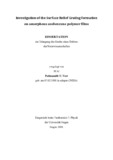Zitierlink:
https://nbn-resolving.org/urn:nbn:de:hbz:467-4104Dateien zu dieser Ressource:
| Datei | Beschreibung | Größe | Format | |
|---|---|---|---|---|
| veer.pdf | 2.96 MB | Adobe PDF |  Öffnen/Anzeigen |
| Dokumentart: | Doctoral Thesis | Titel: | Investigation of the surface relief grating formation on amorphous azobenzene polymer films | AutorInn(en): | Veer, Padmanabh | Institut: | Fachbereich 7, Physik | Schlagwörter: | surface relief gratings, azobenzene polymer, pDR1M, pMEA, viscoplastic model | DDC-Sachgruppe: | 530 Physik | GHBS-Notation: | UIYF | Erscheinungsjahr: | 2009 | Publikationsjahr: | 2009 | Zusammenfassung: | The most staggering effect in photosensitive organic thin films is the formation of surface relief gratings (SRGs) onto thin azobenzene polymer films. The phenomenon was reported independently by two different groups in 1995. These gratings can be inscribed onto thin films of azobenzene polymer films using intensity or polarisation modulations resulting from an interference pattern. Using a wavelength corresponding to the absorption maxima of the azobenzene moiety, grating of several hundreds of nanometre heights, depending upon initial film thickness, can be easily written well below the glass transition temperature. Several models have been proposed to describe the process of grating formation and to explain the origin of the force, forming these gratings but none of these theories could explain the complete process depending upon various parameters like polarisation, photo-induced softening and the origin of the inscribing force. The scope of this thesis work is to find out the origin of the stress which leads to the formation of grating onto the azobenzene polymer film and to support the experimental data with an appropriate model. From all the theories and previously reported scientific papers, it has been seen that trans-cis-trans photo-isomerization is the initiative of the orientation phenomenon within azobenzene polymer. Considering this fact, the interaction of azobenzene chromophores with the polarised light leads to the orientation of the whole polymer chain along with the azobenzene chromophores was our assumption about the formation process. The orientation of azo chromophores leads to the generation of the mechanical stress necessary for the formation of the gratings. To verify the orientation mechanism, I studied the formation of surface relief grating by continuous and pulsed exposure techniques with respect to temperature. The temperature dependent continuous exposure measurements have revealed the ordering of chromophores at room temperature and disordering at higher temperature whereas the temperature dependent pulsed exposure measurements have revealed the orientation and relaxation of chromophores. The experimental results were found to support the assumption of orientation mechanism. The orientation mechanism was also studied in the context of the dipole moment of the two different azobenzene polymers namely pDR1M and pMEA having dipole moments µ=7.0D and µ=0.05D respectively. From this study it was found that the orientation rate is higher for high dipole moment pDR1M compared to low dipole pMEA. Most of the theories support the assumption of softening of the azobenzene polymer film under visible irradiation, at least three orders of magnitude less compared to the room temperature as found near the glass transition temperature of the polymer and hence predict a light induced stress of σ<1Kpa for the inscription of grating. The logical consequence of this assumption is that inscription of surface relief gratings should become more effective upon approaching the glass transition region of the azobenzene polymer. The temperature dependent continuous and pulsed exposure results are contradictory to the above statement. The grating formation diminishes approaching the glass transition temperature of the polymer. Also in this study, It was possible to predict the magnitude of the stress generated during the orientation mechanism of azobenzene and its relation to the laser power. The magnitude of the stress is found to be enough to deform the glassy polymer at room temperature during the process of grating formation. The stress is higher than the yield stress of the typical polymer like pDR1M, (σY=50MPa). The obtained data of the temperature dependent measurements can be very well explained in frame of the viscoelastic model. Further the decomposition of the total external stress obtained from the simulation data into yield stress and viscoplastic stress can lead to the up- gradation of viscoelastic model into viscoplastic model which is found to be the appropriate model for the description of deformation of a polymers in its glassy state. Finally, the alteration of the mechanical properties of the polymer film during the process of grating formation have been reported. The ex-situ investigation was carried out by spatially resolved hardness measurements using atomic force microscope (AFM) to clarify the process at microscopic level. It can be concluded that the polymer chains are uniformly arranged with respect to each other at the crests of the grating. This uniformity and higher density increases the hardness of the polymer material at crests compared to the non uniform arrangement at troughs. |
URN: | urn:nbn:de:hbz:467-4104 | URI: | https://dspace.ub.uni-siegen.de/handle/ubsi/410 | Lizenz: | https://dspace.ub.uni-siegen.de/static/license.txt |
| Enthalten in den Sammlungen: | Hochschulschriften |
Diese Ressource ist urheberrechtlich geschützt. |
Seitenansichten
404
checked on 25.11.2024
Download(s)
106
checked on 25.11.2024
Google ScholarTM
Prüfe
Alle Ressourcen in diesem Repository sind urheberrechtlich geschützt, soweit nicht anderweitig angezeigt.

